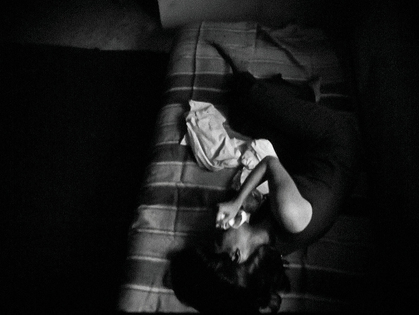
R
E
V N
E
X
T
Ali Kazma: Souterrain
ALI KAZMA, Calligraphy, 2013, still from single-channel video with color and sound: 6 min. Courtesy the artist, Istanbul Foundation for Culture and Arts and Jeu de Paume, Paris.
Oct 17–Jan 21, 2018
Jeu De Paume, Paris, France
“Souterrain” (meaning “underground”), aims to illustrate Turkish artist Ali Kazma’s artistic oeuvre of the last ten years. Kazma, who represented his country in the Venice Biennale in 2013, uses short, multi-channel videos to highlight the socio-economic and political tensions within Turkey, and encourages his audience to reassess how bodies are influenced by external societal factors such as the privatization of spaces and rapid urban transformations. The exhibition will feature 20 video works, including the artist’s ongoing projects such as Obstructions (2005– ) and Resistance (2012– ), as well as two newly commissioned pieces and a photographic publication.
Nalini Malani: The Rebellion of the Dead
Oct 18–Jan 8, 2018
Centre Pompidou, Paris, France
Nalini Malani’s retrospective “The Rebellion of the Dead” will delve into the artist’s 50-year long career, featuring works created between 1969 and 2017. Highlights include the first public display of Still Life, Onanism and Taboo (all created between 1969–76), which are deeply personal and evocative black-and-white 16mm films that present explorations of the female subject. Malani’s multimedia installations and reverse-plastic paintings, such as Remember Mad Meg (2007–2011) will also be shown. The artist’s works provide a critical commentary on the political situation in India, while also delving into the geopolitical power dynamics of the globalizing world. Malani’s show marks Centre Pompidou’s first retrospective of an Indian artist. The exhibition will tour to Castello di Rivoli, Turin, in March, 2018.
Jakarta Biennale 2017: Jiwa
MARINTAN SIRAIT, Long Distance Call From Home, 2012, documentation of performance at “Undisclosed Territory,” Surakarta, 2012. Photo by Arief Budianto. Courtesy Jakarta Biennale 2017: Jiwa.
Nov 4–Dec 11
Various locations, Jakarta, Indonesia
Led by pioneering Indonesian performance artist Melati Suryodarmo, the 2017 edition of the Jakarta Biennale takes the concept of jiwa, meaning “soul,” as its departure point. “Jiwa” proposes that we pay attention to the immaterial forces that shape individuals, societies and nature, highlighting various faculties—including the sensuous, affective and cognitive—with which we are equipped to register such energies. Jiwa is also taken to be a cultural construct through which artists and viewers can re-examine the history of aesthetics and Indonesian identity. The exhibition will feature 51 artists from across the world, including Marintan Sirait, Hito Steyerl, Dana Awartani, Nikhil Chopra, Hendrawan Riyanto and Robert Zhao Renhui.
Qu Leilei: A Chinese Artist in Britain
Nov 7–Apr 15, 2018
Ashmolean Museum, Oxford, UK
“A Chinese Artist in Britain” brings the works of one of China’s most prominent contemporary ink artists, Qu Leilei, to Oxford, England. The show draws from the London-based artist’s vast oeuvre to chart “the dramatic development of this influential artist over the past three decades.” Exhibits will include ink drawings, collages and paintings created between the late-1970s to mid-1980s, when the artist co-founded the Stars Group in Beijing—the first Chinese avant-garde art movement—as well as some of Qu’s recent calligraphic paintings such as Autumn (2016), which takes the iconic Radcliffe Camera building at the University of Oxford as its visual inspiration.
Home Beirut. Sounding the Neighbors
Nov 15–May 20, 2018
MAXXI, Rome, Italy
Co-curated by Hou Hanru and Giulia Ferracci, “Home Beirut. Sounding the Neighbors” is the third installment in a trilogy of exhibitions that examine the interactions between the artistic communities of Europe and the Middle East. The Beirut edition fittingly hones in on the historical city as a site of both destruction and rebirth, and will showcase the works of 30 multi-disciplinary practitioners including Etel Adnan, Walid Raad, Akram Zaatari, Mona Hatoum, Rania Stephan and Ali Cherri to critically reflect on the region’s history of conflict, as well as its ongoing transformations and prospects for the future.
Mori Art Museum Project 024: Dane Mitchell
DANE MITCHELL, Iris, Iris, Iris (study), 2017, archival inkjet print, 50 × 50 cm. Courtesy the artist, Hopkinson Mossman, Auckland and Christopher Grimes, Los Angeles.
Nov 18–Apr 1, 2018
Mori Art Museum, Tokyo, Japan
Auckland and Berlin-based artist Dane Mitchell is known for his sculptural assemblages and spatial experiences that examine the invisible underpinnings of how we construct and gather knowledge—in particular, Mitchell investigates the realm of smell. For his solo exhibition at the Mori Art Museum, the artist researched the world of traditional Japanese incense and irises—as in part of the eye, a species of flower, an optical device in cameras, as well as a Greek goddess—to uncover the link and disconnect between the visual and the olfactory, the visible and invisible.








